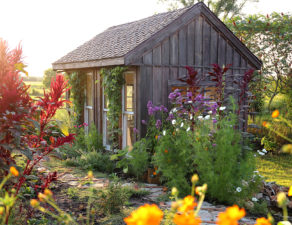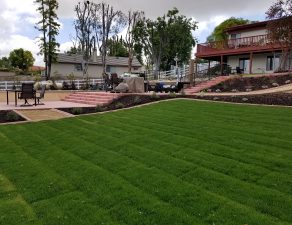
Most of us think of gardens as something beautiful to look at. However, a sensory garden can be designed to appeal to all five of your senses, so that spending time in your backyard can become a relaxing, immersive experience. Since research has shown that spending time outdoors can lower blood pressure and reduce stress, designing a sensory garden could be good for your health.
Ideas for your sensory garden are as limitless as your imagination, but the following tips can get you going. You can come up with some unique ideas of your own!
Appeal to sight.
• When choosing flowers, consider the season and time of day that different varieties bloom.
• Try contrasting shapes, sizes, and colors grouped together.
• Prune cypresses and pines into interesting shapes.
• Use large shrubs or trees to hide unappealing parts of your yard or exterior of your house.
• Incorporate unusual items like wheelbarrow planters, sundials, bird baths, and so on.
• Plant long grasses or weeping trees; their movement is relaxing to watch.
Incorporate soothing sounds.
• Install a water feature such as a fountain.
• Choose plants that produce nectar, or install a bird bath, to attract song birds.
• Hang a wind chime on the porch.
• A textured pathway made of gravel or small pebbles, produces a soothing sound when you walk on it.
• Consider a border of thick hedges, a living wall, and other barriers to help block road noise.
Provide your nose with appealing scents.
• Consider scents when selecting flowers for your garden. Violets provide a subtle scent, lavender is relaxing, and many people enjoy the vibrant smells of English roses.
• Consider spacing when selecting these blooms. You don’t want to be overwhelmed by too many different smells at once.
Create a garden you want to touch.
• We often choose plants based on their appearance, but also consider the way they feel.
• Visit our nursery to discover foliage that is fuzzy, velvety, feathery, and so on.
• Plan both sunny and shady areas, so that you can enjoy soaking up warm sunshine or escaping the heat, as you please.
• Avoid plants with thorns, particularly in sitting areas or along paths where you might brush against them.
Grow a “tasteful” garden.
• Include plants that you can eat! Fresh herb cuttings taste so much better than the dried varieties.
• Consider flowering plants with edible blooms; nasturtiums and violets add a wonderful touch to salads.
• Consider planting vegetables such as tomatoes.
• Plant a fruit tree.
These are a just a few ideas to get you started. Visit our nursery, walk around, and talk to our staff to gather more ideas for your sensory garden. As always, we’re happy to offer expert advice to help you create the garden of your dreams.









Write a comment: